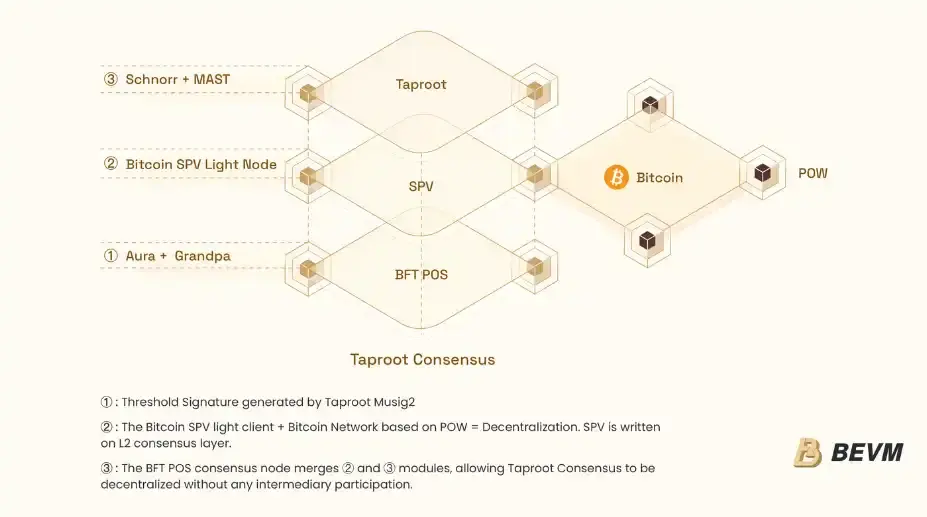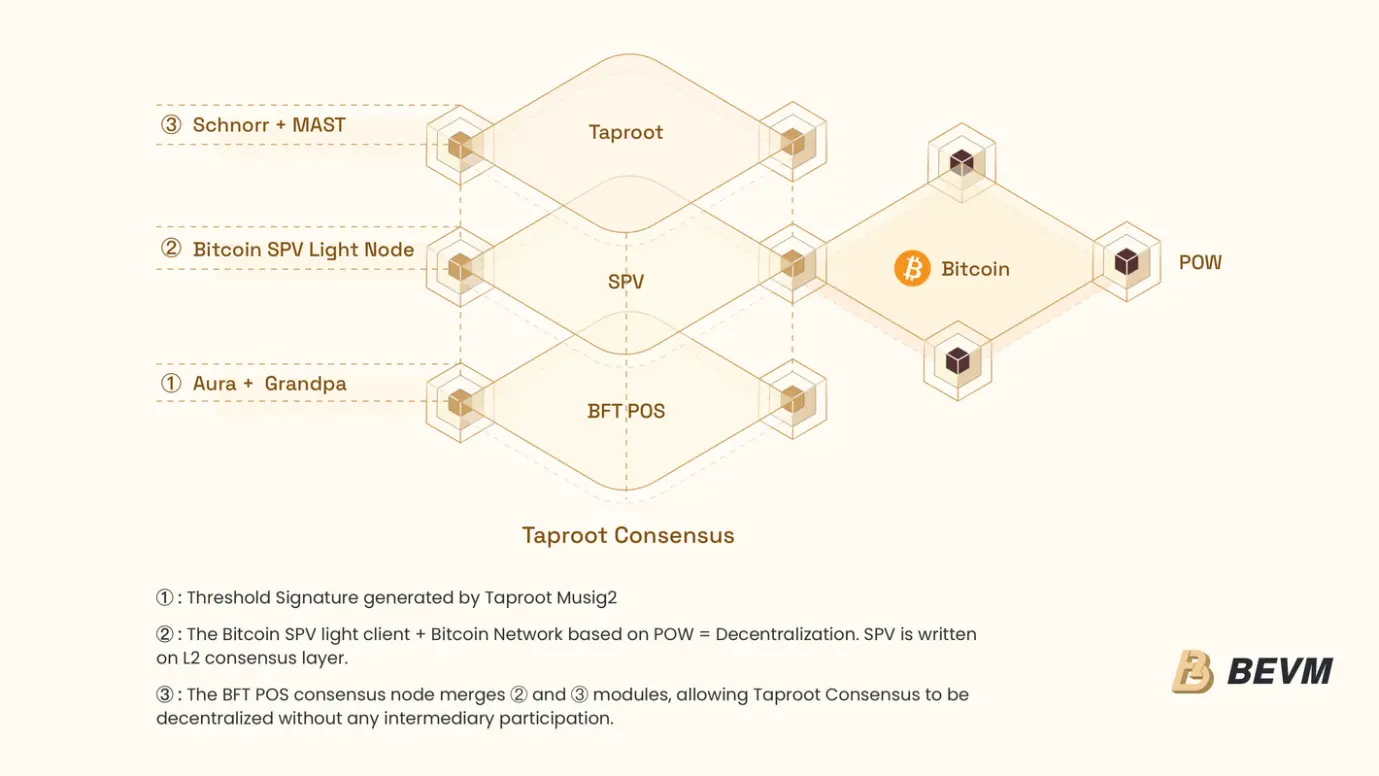The Ultimate Integration of Bitcoin Native Expansion Technology: A Comprehensive Interpretation of the BEVM Technical White Paper
Preface:
On May 20, 2024, the Bitcoin Layer2 development team BEVM officially released the technical white paper titled "Taproot Consensus: A Decentralized BTC Layer2 Solution."
The white paper provides a detailed description of how Taproot Consensus is implemented and how it combines Bitcoin's native technologies such as Schnorr signatures, MAST, and Bitcoin SPV nodes to construct a fully decentralized BTC Layer2 solution.
After reading through it, I feel that the Taproot Consensus solution proposed by the BEVM team is a culmination of truly Bitcoin-native expansion technologies. Taproot Consensus does not modify or add to Bitcoin's code but innovatively combines several of Bitcoin's native technologies in a straightforward and cleverly structured manner.
Before formally interpreting the white paper, it is necessary to review the history of Bitcoin's technological iterations to better understand how Taproot Consensus has evolved from the development context of Bitcoin.
Main Body:
1. The History of Bitcoin's Technological Iteration
October 31, 2008
Satoshi Nakamoto published a paper titled "Bitcoin: A Peer-to-Peer Electronic Cash System," officially proposing a complete technical implementation of Bitcoin.
In Chapter 8 of the paper, Satoshi mentioned a solution called SPV (Simple Payment Verification), which is a technique that allows for payment verification without running a full Bitcoin node, simply by saving the block headers.
January 3, 2009
Satoshi mined the genesis block on a small server located in Helsinki, marking the official birth of Bitcoin.
It is worth mentioning that in the official Bitcoin code, Satoshi used the Elliptic Curve Digital Signature Algorithm (ECDSA) but did not adopt the more suitable Schnorr signature technology. The reason is not that ECDSA is superior to Schnorr signatures, but rather that at the time, Schnorr signatures were not open-sourced and were still under patent protection. Therefore, Satoshi opted for the already open-sourced ECDSA.
Schnorr signatures retain all the functionalities and security assumptions of ECDSA while overcoming the limitation of ECDSA's maximum of 15 signatures in Bitcoin's technical framework, ultimately allowing for the management of 1000+ addresses without affecting signature speed.
2018
After years of repeated validation, Bitcoin core developers Gregory Maxwell and others formally proposed a BIP, suggesting the introduction of Schnorr signatures into the Bitcoin network.
November 14, 2021
Bitcoin officially completed the Taproot upgrade, and Schnorr signatures were formally incorporated into the Bitcoin network, ushering in a new era of decentralized multi-signatures for Bitcoin.
In addition to Schnorr signatures, the Taproot upgrade also introduced MAST (Merkelized Abstract Syntax Trees), a technology that enables Bitcoin to have smart contract-like functionalities by organizing the logical conditions of multiple contract branches into a Merkle tree format, allowing Bitcoin code to meet similar functional requirements (but limited to Bitcoin payment verification, unlike Ethereum's complex smart contracts).
Schnorr signatures can achieve 1000+ multi-signature addresses, while MAST can drive Schnorr signature addresses for multi-signatures through Bitcoin programs. Therefore, Schnorr signatures + MAST can create a decentralized Bitcoin multi-signature network driven by Bitcoin code instructions rather than requiring human signatures.
This means that Bitcoin can escape the constraints of a single layer in a trustless manner, allowing for more complex and richer business scenarios to be realized on Bitcoin Layer 2.


The Taproot Consensus solution proposed by the BEVM team is a culmination of Bitcoin's technological iterations from 2008 to 2021.
2. Overview of the Taproot Consensus Solution:
The Taproot Consensus technical white paper begins by stating: "The non-Turing complete nature of the Bitcoin network limits its ability to directly implement Layer2 expansion solutions similar to Ethereum Rollup. The script contract layer of the Bitcoin network can only perform simple transfer operations and cannot support more complex smart contract functionalities. Therefore, constructing a Layer2 expansion solution solely from the Bitcoin script layer is not feasible."
This introductory description is highly concise, pointing out the non-Turing completeness of the Bitcoin network and that Bitcoin's script contracts can only execute Bitcoin transfer operations. Thus, the correct direction for Bitcoin expansion is not to work on the Bitcoin Layer 1 network but to utilize Bitcoin's existing capabilities to build a fully decentralized Bitcoin Layer 2 expansion solution.
Taproot Consensus integrates Bitcoin's Taproot technology (Schnorr signatures and MAST), Bitcoin SPV light nodes, and the BFT PoS consensus mechanism to construct a decentralized and highly consistent Layer2 network.
3. Detailed Explanation of the Taproot Consensus Architecture
The Taproot Consensus proposed by the BEVM team consists of three parts: Schnorr+Mast, Bitcoin SPV, and Aura+Grandpa.
Schnorr+Mast has been mentioned earlier; by combining these two native technologies brought by the Bitcoin Taproot upgrade, decentralized multi-signature management for Bitcoin can be achieved without requiring human signatures, instead using Bitcoin code to drive the process.
So, who drives these codes? It is driven by the consensus achieved through the Layer 2 network.
How does the Layer 2 network reach consensus, and how does this consensus synchronize with the state of Bitcoin Layer 1?
This is where the utility of Bitcoin SPV + BFT PoS consensus (Aura + Grandpa) comes into play.
Bitcoin SPV is the simple payment verification method proposed by Satoshi, which allows for the synchronization and verification of Bitcoin transactions without running a full node. This feature enables Taproot Consensus to synchronize BTC states in a completely decentralized environment without any permission.
Aura + Grandpa is a more general implementation of Byzantine Fault Tolerance (BFT) advanced PoS consensus protocol, ensuring high consistency among network nodes through distributed protocols (most blockchains built on the Substrate framework use Aura + Grandpa).
Therefore, to summarize, the operational principles of the three parts of Taproot Consensus are:
"In the BEVM system, each validator holds a BTC private key for Schnorr signatures. The characteristics of Schnorr signatures allow for efficient signature aggregation, thereby enhancing the security and efficiency of the system. The aggregated public key Pagg generated through the Musig2 multi-signature scheme forms a large MAST (Merkle Abstract Syntax Tree).
After generating the root hash of the MAST tree, validators perform BTC transfers and inscription operations to the threshold signature address generated by the MAST tree, enabling the submission of data from the BTC mainnet to the BEVM network. At the same time, each validator acts as a Bitcoin SPV (Simplified Payment Verification) light node, allowing them to securely and permissionlessly synchronize the BTC network state."
In summary:
Taproot Consensus constructs decentralized BTC multi-signature management on Bitcoin Layer 1 using Schnorr+Mast, while Layer 2 operates a Bitcoin SPV node network. For example, the BEVM Layer 2 network runs entirely on Bitcoin SPV nodes, which can synchronize the data state of Bitcoin Layer 1, allowing BEVM and Bitcoin Layer 1 to synchronize information. To ensure that the Layer 2 network is secure and trustworthy, BEVM integrates the Bitcoin SPV node network with Aura + Grandpa, giving the Bitcoin SPV node network a BFT consensus level of security. Thus, the management of BEVM network assets relies not on specific multi-signers but on BFT consensus to achieve true decentralization.
4. Other Technical Details in the White Paper
In addition to the above technical framework, the Taproot Consensus white paper also explains in detail the implementation details of Schnorr signatures, MAST, Bitcoin PSV light nodes, Aura + Grandpa, and other technologies. For those who want to learn and understand the latest Bitcoin technologies, the Taproot Consensus white paper produced by the BEVM team is a very comprehensive and detailed learning resource.
Moreover, the white paper also elaborates on the implementation process of Musig2 and the differences between the well-known BTC Layer2 project Mezo and Taproot Consensus.
Mezo's underlying technical structure is based on the tBTC protocol. tBTC utilizes Bitcoin multi-signatures to construct a threshold signature network, which has stronger consistency compared to traditional distributed networks.
However, tBTC is still a multi-signer network that requires 9 signatures. To truly achieve a system that does not rely on people but is driven by consensus, it is necessary to combine the multi-signature network with the BFT PoS (Byzantine Fault Tolerant Proof of Stake) consensus mechanism. (This is also the difference between distributed networks and blockchains; distributed networks emphasize distribution but lack Byzantine fault tolerance consensus, while blockchains are also distributed networks but rely on Byzantine fault tolerance consensus to drive them, thus being truly decentralized networks.)
The Taproot Consensus solution adopts this more advanced design. By combining Schnorr signatures, MAST, Bitcoin SPV light nodes, and the Aura and Grandpa Byzantine fault tolerance consensus mechanisms, it constructs a highly consistent and secure decentralized Layer2 expansion solution. This integration not only enhances the scalability and usability of the Bitcoin network but also ensures the security and consistency of the BEVM network.
Conclusion:
The technical white paper released by the BEVM team systematically and comprehensively describes the implementation plan and technical details of Taproot Consensus, showcasing a Bitcoin Layer 2 solution built entirely on Bitcoin's native technologies.
Taproot Consensus not only respects and inherits the original technical direction of Bitcoin but also combines the technologies brought by Bitcoin's various upgrades for innovative integration, making it a true culmination of Bitcoin-native expansion technologies.
As the Bitcoin ecosystem continues to develop, people will gradually realize that a truly decentralized Bitcoin Layer 2 solution is the inevitable path for the development of the Bitcoin ecosystem, and solutions like Taproot Consensus will truly shine.








